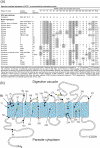PfCRT and its role in antimalarial drug resistance
- PMID: 23020971
- PMCID: PMC3478492
- DOI: 10.1016/j.pt.2012.08.002
PfCRT and its role in antimalarial drug resistance
Abstract
Plasmodium falciparum resistance to chloroquine, the former gold standard antimalarial drug, is mediated primarily by mutant forms of the chloroquine resistance transporter (PfCRT). These mutations impart upon PfCRT the ability to efflux chloroquine from the intracellular digestive vacuole, the site of drug action. Recent studies reveal that PfCRT variants can also affect parasite fitness, protect immature gametocytes against chloroquine action, and alter P. falciparum susceptibility to current first-line therapies. These results highlight the need to be vigilant in screening for the appearance of novel pfcrt alleles that could contribute to new multi-drug resistance phenotypes.
Copyright © 2012 Elsevier Ltd. All rights reserved.
Figures


Similar articles
-
Combinatorial Genetic Modeling of pfcrt-Mediated Drug Resistance Evolution in Plasmodium falciparum.Mol Biol Evol. 2016 Jun;33(6):1554-70. doi: 10.1093/molbev/msw037. Epub 2016 Feb 22. Mol Biol Evol. 2016. PMID: 26908582 Free PMC article.
-
A Variant PfCRT Isoform Can Contribute to Plasmodium falciparum Resistance to the First-Line Partner Drug Piperaquine.mBio. 2017 May 9;8(3):e00303-17. doi: 10.1128/mBio.00303-17. mBio. 2017. PMID: 28487425 Free PMC article.
-
Molecular Mechanisms of Drug Resistance in Plasmodium falciparum Malaria.Annu Rev Microbiol. 2020 Sep 8;74:431-454. doi: 10.1146/annurev-micro-020518-115546. Annu Rev Microbiol. 2020. PMID: 32905757 Free PMC article. Review.
-
Identification of a mutant PfCRT-mediated chloroquine tolerance phenotype in Plasmodium falciparum.PLoS Pathog. 2010 May 13;6(5):e1000887. doi: 10.1371/journal.ppat.1000887. PLoS Pathog. 2010. PMID: 20485514 Free PMC article.
-
Is PfCRT a channel or a carrier? Two competing models explaining chloroquine resistance in Plasmodium falciparum.Trends Parasitol. 2007 Jul;23(7):332-9. doi: 10.1016/j.pt.2007.04.013. Epub 2007 May 10. Trends Parasitol. 2007. PMID: 17493873 Review.
Cited by
-
Whole-Genome Sequencing to Evaluate the Resistance Landscape Following Antimalarial Treatment Failure With Fosmidomycin-Clindamycin.J Infect Dis. 2016 Oct 1;214(7):1085-91. doi: 10.1093/infdis/jiw304. Epub 2016 Jul 20. J Infect Dis. 2016. PMID: 27443612 Free PMC article.
-
Dual-functioning antimalarials that inhibit the chloroquine-resistance transporter.Future Microbiol. 2013 Apr;8(4):475-89. doi: 10.2217/fmb.13.18. Future Microbiol. 2013. PMID: 23534360 Free PMC article. Review.
-
Persistent Submicroscopic Plasmodium falciparum Parasitemia 72 Hours after Treatment with Artemether-Lumefantrine Predicts 42-Day Treatment Failure in Mali and Burkina Faso.Antimicrob Agents Chemother. 2021 Jul 16;65(8):e0087321. doi: 10.1128/AAC.00873-21. Epub 2021 Jul 16. Antimicrob Agents Chemother. 2021. PMID: 34060901 Free PMC article.
-
Seasonal Malaria Chemoprevention with Sulphadoxine-Pyrimethamine and Amodiaquine Selects Pfdhfr-dhps Quintuple Mutant Genotype in Mali.PLoS One. 2016 Sep 23;11(9):e0162718. doi: 10.1371/journal.pone.0162718. eCollection 2016. PLoS One. 2016. PMID: 27662368 Free PMC article.
-
Tricks in Plasmodium's molecular repertoire--escaping 3'UTR excision-based conditional silencing of the chloroquine resistance transporter gene.Int J Parasitol. 2012 Oct;42(11):969-74. doi: 10.1016/j.ijpara.2012.09.003. Epub 2012 Sep 27. Int J Parasitol. 2012. PMID: 23023047 Free PMC article.
References
-
- Trape JF, et al. Combating malaria in Africa. Trends Parasitol. 2002;18:224–230. - PubMed
-
- Nosten F, White NJ. Artemisinin-based combination treatment of falciparum malaria. Am. J. Trop. Med. Hyg. 2007;77:181–192. - PubMed
-
- Wells TN, et al. New medicines to improve control and contribute to the eradication of malaria. Nat. Rev. Drug Discov. 2009;8:879–891. - PubMed
Publication types
MeSH terms
Substances
Grants and funding
LinkOut - more resources
Full Text Sources

